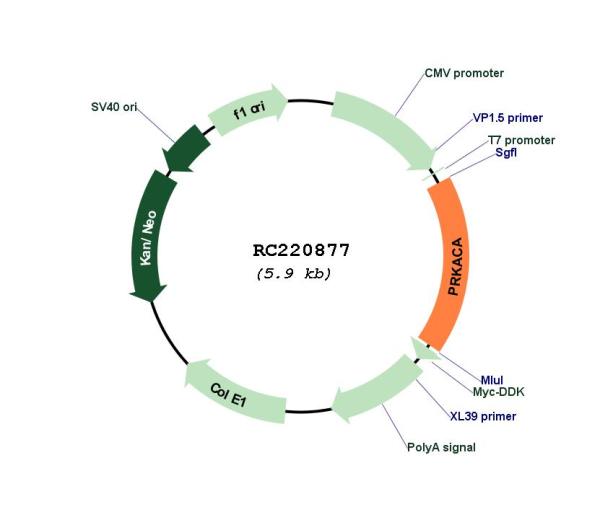PRKACA (NM_207518) Human Tagged ORF Clone
CAT#: RC220877
PRKACA (Myc-DDK-tagged)-Human protein kinase, cAMP-dependent, catalytic, alpha (PRKACA), transcript variant 2
ORF Plasmid: tGFP
Lentiviral Particles: DDK w/ Puro mGFP w/ Puro
"NM_207518" in other vectors (4)
USD 198.00
Specifications
| Product Data | |
| Type | Human Tagged ORF Clone |
| Tag | Myc-DDK |
| Symbol | PRKACA |
| Synonyms | CAFD1; PKACA; PPNAD4 |
| Vector | pCMV6-Entry |
| E. coli Selection | Kanamycin (25 ug/mL) |
| Mammalian Cell Selection | Neomycin |
| Sequence Data |
>RC220877 representing NM_207518
Red=Cloning site Blue=ORF Green=Tags(s) TTTTGTAATACGACTCACTATAGGGCGGCCGGGAATTCGTCGACTGGATCCGGTACCGAGGAGATCTGCC GCCGCGATCGCC ATGGCTTCCAACTCCAGCGATGTGAAAGAATTCTTAGCCAAAGCCAAAGAAGATTTTCTTAAAAAATGGG AAAGTCCCGCTCAGAACACAGCCCACTTGGATCAGTTTGAACGAATCAAGACCCTCGGCACGGGCTCCTT CGGGCGGGTGATGCTGGTGAAACACAAGGAGACCGGGAACCACTATGCCATGAAGATCCTCGACAAACAG AAGGTGGTGAAACTGAAACAGATCGAACACACCCTGAATGAAAAGCGCATCCTGCAAGCTGTCAACTTTC CGTTCCTCGTCAAACTCGAGTTCTCCTTCAAGGACAACTCAAACTTATACATGGTCATGGAGTACGTGCC CGGCGGGGAGATGTTCTCACACCTACGGCGGATCGGAAGGTTCAGTGAGCCCCATGCCCGTTTCTACGCG GCCCAGATCGTCCTGACCTTTGAGTATCTGCACTCGCTGGATCTCATCTACAGGGACCTGAAGCCGGAGA ATCTGCTCATTGACCAGCAGGGCTACATTCAGGTGACAGACTTCGGTTTCGCCAAGCGCGTGAAGGGCCG CACTTGGACCTTGTGCGGCACCCCTGAGTACCTGGCCCCTGAGATTATCCTGAGCAAAGGCTACAACAAG GCCGTGGACTGGTGGGCCCTGGGGGTTCTTATCTATGAAATGGCCGCTGGCTACCCGCCCTTCTTCGCAG ACCAGCCCATCCAGATCTATGAGAAGATCGTCTCTGGGAAGGTGCGCTTCCCTTCCCACTTCAGCTCTGA CTTGAAGGACCTGCTGCGGAACCTCCTGCAGGTAGATCTCACCAAGCGCTTTGGGAACCTCAAGAATGGG GTCAACGATATCAAGAACCACAAGTGGTTTGCCACAACTGACTGGATTGCCATCTACCAGAGGAAGGTGG AAGCTCCCTTCATACCAAAGTTTAAAGGCCCTGGGGATACGAGTAACTTTGACGACTATGAGGAAGAAGA AATCCGGGTCTCCATCAATGAGAAGTGTGGCAAGGAGTTTTCTGAGTTT ACGCGTACGCGGCCGCTCGAGCAGAAACTCATCTCAGAAGAGGATCTGGCAGCAAATGATATCCTGGATT ACAAGGATGACGACGATAAGGTTTAA >RC220877 representing NM_207518
Red=Cloning site Green=Tags(s) MASNSSDVKEFLAKAKEDFLKKWESPAQNTAHLDQFERIKTLGTGSFGRVMLVKHKETGNHYAMKILDKQ KVVKLKQIEHTLNEKRILQAVNFPFLVKLEFSFKDNSNLYMVMEYVPGGEMFSHLRRIGRFSEPHARFYA AQIVLTFEYLHSLDLIYRDLKPENLLIDQQGYIQVTDFGFAKRVKGRTWTLCGTPEYLAPEIILSKGYNK AVDWWALGVLIYEMAAGYPPFFADQPIQIYEKIVSGKVRFPSHFSSDLKDLLRNLLQVDLTKRFGNLKNG VNDIKNHKWFATTDWIAIYQRKVEAPFIPKFKGPGDTSNFDDYEEEEIRVSINEKCGKEFSEF TRTRPLEQKLISEEDLAANDILDYKDDDDKV |
| Chromatograms |
CHROMATOGRAMS
 Sequencher program is needed, download here. |
| Restriction Sites |
SgfI-MluI
Cloning Scheme for this gene
Plasmid Map

|
| ACCN | NM_207518 |
| ORF Size | 1029 bp |
| OTI Disclaimer | Due to the inherent nature of this plasmid, standard methods to replicate additional amounts of DNA in E. coli are highly likely to result in mutations and/or rearrangements. Therefore, OriGene does not guarantee the capability to replicate this plasmid DNA. Additional amounts of DNA can be purchased from OriGene with batch-specific, full-sequence verification at a reduced cost. Please contact our customer care team at custsupport@origene.com or by calling 301.340.3188 option 3 for pricing and delivery. The molecular sequence of this clone aligns with the gene accession number as a point of reference only. However, individual transcript sequences of the same gene can differ through naturally occurring variations (e.g. polymorphisms), each with its own valid existence. This clone is substantially in agreement with the reference, but a complete review of all prevailing variants is recommended prior to use. More info |
| OTI Annotation | This clone was engineered to express the complete ORF with an expression tag. Expression varies depending on the nature of the gene. |
| Product Components | The ORF clone is ion-exchange column purified and shipped in a 2D barcoded Matrix tube containing 10ug of transfection-ready, dried plasmid DNA (reconstitute with 100 ul of water). |
| Reconstitution | 1. Centrifuge at 5,000xg for 5min. 2. Carefully open the tube and add 100ul of sterile water to dissolve the DNA. 3. Close the tube and incubate for 10 minutes at room temperature. 4. Briefly vortex the tube and then do a quick spin (less than 5000xg) to concentrate the liquid at the bottom. 5. Store the suspended plasmid at -20°C. The DNA is stable for at least one year from date of shipping when stored at -20°C. |
| Reference Data | |
| RefSeq | NM_207518.3 |
| RefSeq Size | 2490 bp |
| RefSeq ORF | 1032 bp |
| Locus ID | 5566 |
| UniProt ID | P17612 |
| Cytogenetics | 19p13.12 |
| Protein Families | Druggable Genome, Protein Kinase |
| Protein Pathways | Apoptosis, Calcium signaling pathway, Chemokine signaling pathway, Dilated cardiomyopathy, Gap junction, GnRH signaling pathway, Hedgehog signaling pathway, Insulin signaling pathway, Long-term potentiation, MAPK signaling pathway, Melanogenesis, Olfactory transduction, Oocyte meiosis, Prion diseases, Progesterone-mediated oocyte maturation, Taste transduction, Vascular smooth muscle contraction, Vibrio cholerae infection, Wnt signaling pathway |
| MW | 39.6 kDa |
| Gene Summary | This gene encodes one of the catalytic subunits of protein kinase A, which exists as a tetrameric holoenzyme with two regulatory subunits and two catalytic subunits, in its inactive form. cAMP causes the dissociation of the inactive holoenzyme into a dimer of regulatory subunits bound to four cAMP and two free monomeric catalytic subunits. Four different regulatory subunits and three catalytic subunits have been identified in humans. cAMP-dependent phosphorylation of proteins by protein kinase A is important to many cellular processes, including differentiation, proliferation, and apoptosis. Constitutive activation of this gene caused either by somatic mutations, or genomic duplications of regions that include this gene, have been associated with hyperplasias and adenomas of the adrenal cortex and are linked to corticotropin-independent Cushing's syndrome. Alternative splicing results in multiple transcript variants encoding different isoforms. Tissue-specific isoforms that differ at the N-terminus have been described, and these isoforms may differ in the post-translational modifications that occur at the N-terminus of some isoforms. [provided by RefSeq, Jan 2015] |
Documents
| Product Manuals |
| FAQs |
| SDS |
Resources
Other Versions
| SKU | Description | Size | Price |
|---|---|---|---|
| RC220877L3 | Lenti ORF clone of Human protein kinase, cAMP-dependent, catalytic, alpha (PRKACA), transcript variant 2, Myc-DDK-tagged |
USD 986.00 |
|
| RC220877L4 | Lenti ORF clone of Human protein kinase, cAMP-dependent, catalytic, alpha (PRKACA), transcript variant 2, mGFP tagged |
USD 986.00 |
|
| RG220877 | PRKACA (tGFP-tagged) - Human protein kinase, cAMP-dependent, catalytic, alpha (PRKACA), transcript variant 2 |
USD 886.00 |
|
| SC308605 | PRKACA (untagged)-Human protein kinase, cAMP-dependent, catalytic, alpha (PRKACA), transcript variant 2 |
USD 686.00 |
{0} Product Review(s)
Be the first one to submit a review






























































































































































































































































 Germany
Germany
 Japan
Japan
 United Kingdom
United Kingdom
 China
China





